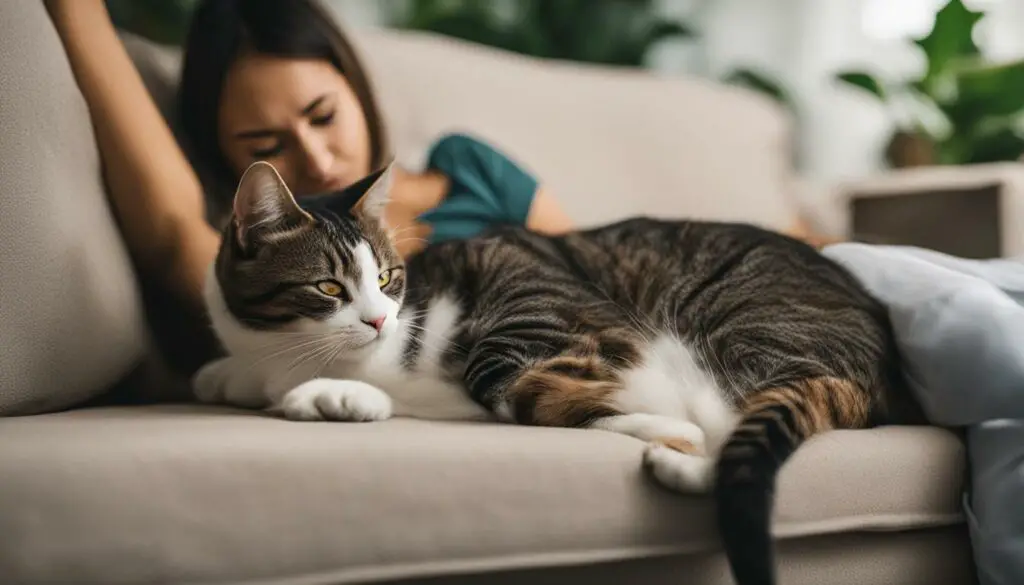If you have a cat that is constantly glued to your lap, it can become quite problematic. In this guide, I will explore effective techniques to gently remove a cat from your lap without disturbing their comfort. We will also address cat behavior and provide training tips to modify their lap-loving habits.
Key Takeaways:
- Understanding cat behavior is crucial when dealing with lap-loving cats
- Gradual behavior modification techniques can be employed to train cats to stay off your lap
- Needy cats require building their confidence, while demanding cats need boundaries and consistency
- Patience and consistency are key in training and modifying cat behavior
- Encouraging lap sitting can be achieved through positive reinforcement and creating a comfortable lap space
Signs of a Needy Cat
Needy cats display certain behaviors that indicate their excessive need for attention and companionship. These signs can help you identify if your cat falls into this category:
- Following you everywhere: Needy cats have a strong desire to be near their owners and will often follow them around the house.
- Positioning themselves directly on top of or in front of what you are using: Needy cats want to be the center of your attention and may try to obstruct your view or access to objects.
- Staring at you constantly: Needy cats will gaze at you intently, hoping to catch your attention and receive affection.
- Refusing to be left alone: Needy cats may become anxious or distressed when left alone and will seek constant company.
- Seizing any opportunity to rub against you or cling to your body: Needy cats crave physical contact and will actively seek out opportunities to touch and cuddle with you.
- Not eating unless you are present: Some needy cats rely on their owners’ presence to feel safe and secure enough to eat.
It’s important to note that while these behaviors may indicate a needy cat, it’s essential to consider other factors such as their overall health and temperament. If you are concerned about your cat’s behavior, it’s always a good idea to consult with a veterinarian or a feline behavior specialist.
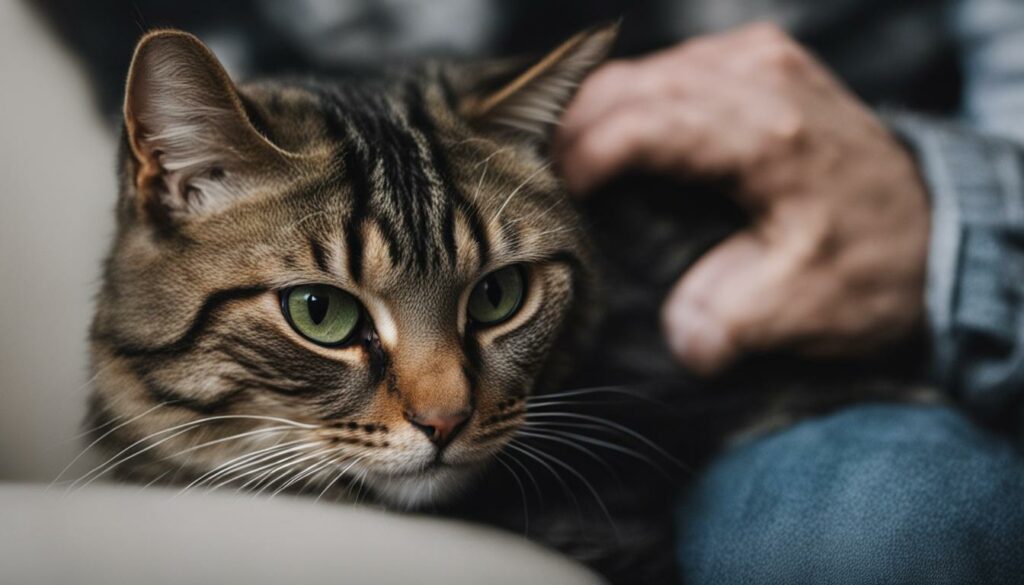
“Needy cats have a strong desire to be near their owners and will often follow them around the house.”
Understanding Needy Behavior
Needy behavior in cats is often rooted in underlying emotional trauma and a lack of self-confidence. These cats seek constant reassurance and attention to feel secure. They may have experienced abandonment or neglect in the past, leading to their need for constant companionship.
Addressing and modifying needy behavior requires patience, consistency, and a gradual approach. By providing a stable and enriching environment, offering positive reinforcement when they exhibit independent behavior, and using techniques to build their confidence, you can help your needy cat develop a healthier and more balanced demeanor.
| Signs of a Needy Cat | Understanding Needy Behavior |
|---|---|
| Following you everywhere | Rooted in underlying emotional trauma |
| Positioning themselves directly on top of or in front of what you are using | Lack of self-confidence |
| Staring at you constantly | Seeking reassurance and attention |
| Refusing to be left alone | Desire for constant companionship |
| Seizing any opportunity to rub against you or cling to your body | Craving physical contact and comfort |
| Not eating unless you are present | Reliance on owner’s presence for security |
If you have a needy cat, it’s important to provide them with the love and attention they need while also encouraging their independence. Building their confidence and helping them feel secure will allow them to develop a more balanced behavior and a stronger bond with you.
Signs of a Demanding Cat
If you have a cat that exhibits demanding behavior, there are several signs to look out for. These behaviors indicate their desire for immediate attention and can be quite persistent. Some common signs of a demanding cat include:
- Yelling at specific meal times
- Meowing incessantly until you pick them up
- Climbing into your lap without invitation
These behaviors may be accompanied by a sense of entitlement and a lack of respect for personal boundaries. It’s important to understand that demanding cats have an abundance of self-assurance and may use manipulative tactics to get what they want.
Dealing with a demanding cat can be challenging, but it’s essential to establish boundaries and maintain consistency in your approach. Ignoring their attention-seeking actions, calmly moving them away when they display demanding behavior, and not rewarding them for their demands are effective strategies to discourage this behavior.
Remember, your cat’s demanding behavior is not a reflection of their love for you, but rather a learned behavior that can be modified with patience, consistency, and positive reinforcement.
Understanding Needy and Demanding Behavior
Needy and demanding behavior in cats can be quite distinct, but both stem from different underlying causes. Needy behavior typically arises from emotional trauma and a lack of self-confidence, while demanding behavior is often rooted in excessive self-assurance and manipulation. To effectively address these behaviors, it’s essential to understand their unique causes and implement targeted training and behavior modification techniques.
Needy Behavior in Cats
Needy cats often crave constant attention and companionship, displaying behaviors such as following you everywhere, rubbing against you incessantly, and refusing to be left alone. This behavior typically arises due to underlying insecurity and a need for reassurance. To address needy behavior, focus on building your cat’s confidence through positive reinforcement, enriching their environment with toys and stimulating activities, and gradually encouraging independence.
Demanding Behavior in Cats
Demanding cats, on the other hand, exhibit behaviors that are driven by their strong desire for immediate attention. They may vocalize loudly, demand physical contact, or forcefully insert themselves into your lap without invitation. This behavior arises from a sense of entitlement and a need to exert control. To address demanding behavior, it’s crucial to set clear boundaries, ignore attention-seeking actions, and reward calm behavior instead. Consistency is key in training demanding cats to respect boundaries and understand that attention is earned, not demanded.
| Behavior | Cause | Training Approach |
|---|---|---|
| Needy | Underlying insecurity and lack of confidence | Building confidence through positive reinforcement and enrichment |
| Demanding | Excessive self-assurance and a need for control | Setting boundaries, ignoring attention-seeking actions, and rewarding calm behavior |
By understanding the distinct causes behind needy and demanding behavior in cats, you can tailor your training techniques to address each behavior effectively. Whether it’s building confidence in needy cats or setting boundaries with demanding ones, patience, consistency, and understanding are essential in helping your cat develop more balanced and manageable behavior patterns.
Addressing Needy Behavior
When dealing with a needy cat, it is important to create a stable and enriching environment for them. Start by ruling out any underlying medical issues that may be causing their clinginess. Once that is done, you can begin implementing gradual behavior modification techniques to help them become more independent.
Building Confidence
One effective technique is gently moving the cat away when they exhibit excessive rubbing or clinging behavior. This helps to establish boundaries and teach them that they can’t always be on your lap. It is important to do this gently and without causing distress to the cat. Additionally, be sure to reward your cat when they exhibit desired behavior, such as exploring and playing independently.
Consistency and Repetition
Consistency is key when training a needy cat. Make sure to be consistent in your approach and repetition is important to reinforce the desired behavior. When implementing the behavior modification techniques, it is helpful to use positive reinforcement. This can involve giving treats or praise when the cat behaves in a more independent manner.
Creating a Supportive Environment
Creating a supportive environment for your needy cat can also help them feel more secure. Provide them with plenty of hiding spots, vertical spaces, and stimulating toys to keep them engaged. Additionally, consider using comforting pheromone sprays or diffusers to help reduce their anxiety. By addressing their needs and providing them with a safe and stimulating environment, you can help your needy cat become more confident and reduce their clingy behavior.
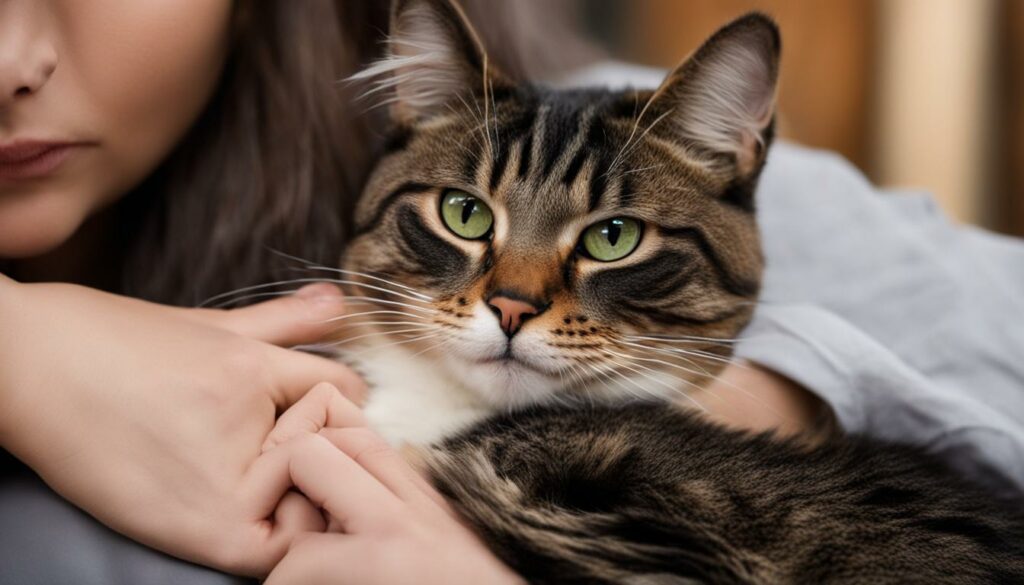
Dealing with Demanding Behavior
Cats with demanding behavior can be quite challenging to handle, but there are effective strategies to set boundaries and modify their behavior. When faced with a cat that demands attention, it’s important to resist the urge to indulge their demands. Instead, calmly move them away and continue to ignore their behavior. This sends a clear message that their attention-seeking actions will not be rewarded.
Consistency is key in training a demanding cat to understand boundaries. Establishing a routine and sticking to it helps reinforce the desired behavior. For example, if your cat meows incessantly for food, establish specific feeding times and only provide food during those times. This helps them learn that food is not always available on demand.
Positive reinforcement is also an effective tool in dealing with demanding behavior. Rewarding your cat when they are calm and not demanding attention will reinforce the desired behavior. This can be done through treats, praise, or playtime. The key is to reward them when they are exhibiting behavior that is more desirable and independent.
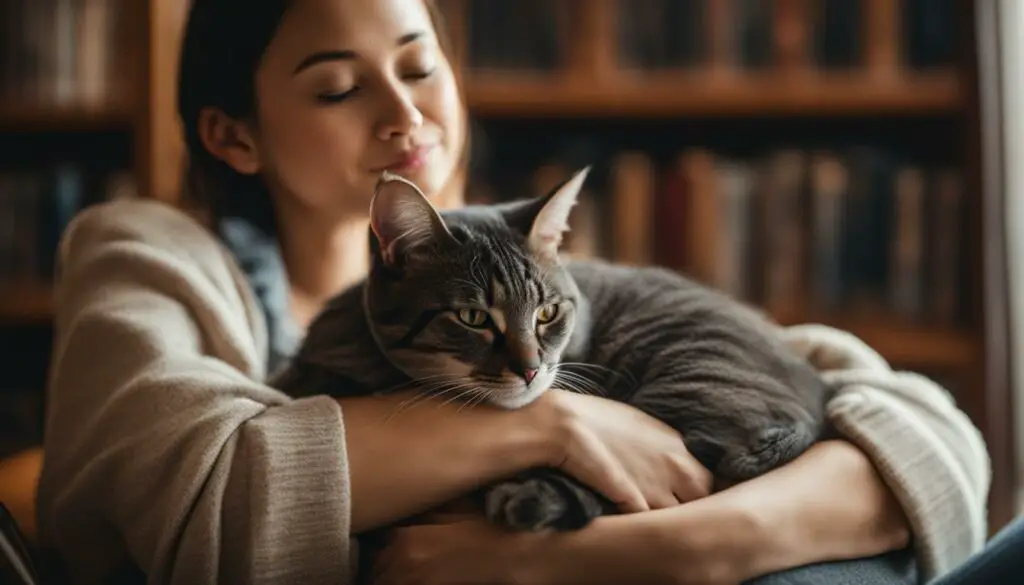
Table: Strategies to Deal with Demanding Behavior in Cats
| Strategy | Description |
|---|---|
| Ignore attention-seeking actions | By ignoring your cat’s attention-seeking actions, you avoid reinforcing the behavior and encourage them to seek attention in more appropriate ways. |
| Establish a routine | Setting specific times for feeding, play, and other activities helps create structure and reduces the need for your cat to demand attention. |
| Use positive reinforcement | Reward your cat with treats, praise, or playtime when they exhibit calm and independent behavior, reinforcing the desired actions. |
| Provide alternative outlets for attention | Engage your cat in interactive play sessions, offer stimulating toys, or provide dedicated spaces where they can engage in independent activities. |
Remember, cats with demanding behavior require patience and consistency in training. It may take time for them to understand and adapt to the boundaries you set. By using positive reinforcement, ignoring attention-seeking actions, and providing alternative outlets for attention, you can help your demanding cat develop more balanced behavior patterns and create a harmonious environment for both of you.
Identifying the Root Cause of Insecurity
When dealing with a cat that exhibits signs of neediness or demanding behavior, it is important to identify the root cause of their insecurities. Understanding what triggers their clinginess or desire for constant attention can help us address these behaviors effectively.
Cats can become insecure due to various reasons, such as changes in their environment or past experiences. Major life events like the departure or addition of a family member, moving to a new home, or even a traumatic incident can contribute to their feelings of insecurity.
By observing their behavior closely, we can gain insights into the specific triggers that lead to their clinginess or demanding nature. Once we have identified the root cause, we can take appropriate steps to create a more secure and stable environment for our furry friends.

Identifying the root cause of a cat’s insecurity is essential in addressing their neediness or demanding behavior. Changes in their environment, such as the departure or addition of a family member, can trigger feelings of insecurity. It is important to observe their behavior and identify any major changes that may have contributed to their clinginess or demanding nature.
Tailoring Your Response to Insecurity
Addressing cat insecurity requires a tailored approach to help your feline companion feel more confident and secure. By understanding the root causes of their insecurity, you can design strategies to support them in building confidence and overcoming their anxious behaviors.
Creating a Stable Environment
One effective way to address cat insecurity is by providing a stable and predictable environment. Cats thrive when they have a routine and know what to expect. Ensure their basic needs, such as food, water, and a clean litter box, are consistently met. Additionally, designate specific areas or spaces for their comfort and safety, such as cozy beds, hiding spots, or elevated perches. These designated spaces can serve as safe zones where your cat can retreat to when they feel anxious or overwhelmed.
Building Confidence through Positive Reinforcement
Positive reinforcement techniques can be powerful tools in building your cat’s confidence. Reward desired behaviors, such as exploring new environments or interacting with unfamiliar objects, with treats, praise, or playtime. By associating positive experiences with situations that trigger their insecurity, you can help your cat overcome their fears and feel more comfortable in various settings.
Patience and Understanding
Addressing cat insecurity requires patience and understanding. Each cat is unique, and progress may be slow. Avoid pushing your cat beyond their comfort zone and instead, allow them to set the pace. Be patient with their progress and never punish them for exhibiting fearful or anxious behaviors. By remaining calm and supportive, you can help your cat feel safe and secure in their environment.
Remember, addressing cat insecurity is a gradual process, and it may take time for your feline companion to overcome their anxieties. Tailor your response to their specific needs, provide a stable environment, and use positive reinforcement techniques to build their confidence. With time, patience, and understanding, you can help your cat feel more secure and lead a happier, more balanced life.
The Role of Patience and Training Cat Behavior
When it comes to modifying cat behavior, patience plays a crucial role. Cats are unique individuals with their own personalities and preferences, and it takes time for them to adjust and overcome their neediness or demanding behavior. Consistency in training techniques is essential, along with positive reinforcement and creating a supportive environment.
Building confidence in cats is an important aspect of training. This can be done through gradual behavior modification techniques, such as gently redirecting them away from excessive rubbing or clinging behavior and rewarding them when they exhibit desired behavior. Consistency and repetition are key in conditioning a needy or demanding cat to become more independent and balanced in their behavior patterns.
In addition to patience and training techniques, providing a stable and enriched environment is essential for modifying cat behavior. This includes ensuring that your cat has access to stimulating toys, scratching posts, and cozy resting areas. Creating a predictable routine and establishing boundaries can also help your cat feel more secure and reduce their neediness or demanding behavior.
Building Confidence in Cats
One effective strategy for building confidence in cats is to engage them in interactive play sessions. This not only provides mental and physical stimulation but also helps them develop a sense of mastery and accomplishment. Additionally, using puzzle toys and providing vertical spaces, such as cat trees or shelves, can give your cat opportunities to explore and exercise their natural climbing instincts.
| Cat Training Techniques | Description |
|---|---|
| Clicker Training | A positive reinforcement technique that uses a clicker to mark desired behavior, followed by a reward. |
| Target Training | Teaching a cat to touch a designated target, such as a stick or hand, to redirect their attention and reinforce positive behavior. |
| Desensitization | Gradually exposing your cat to stimuli that trigger anxiety or fear, in a controlled and positive way, to help them overcome their fears. |
| Counter Conditioning | Pairing a negative stimulus that causes fear or anxiety with a positive stimulus, such as treats or play, to change the emotional response of the cat. |
Remember, each cat is unique, and what works for one may not work for another. It’s important to be patient, observant, and adaptive in your approach to training and modifying cat behavior. With time, consistency, and a supportive environment, you can help your cat develop more balanced behavior patterns and strengthen your bond with them.
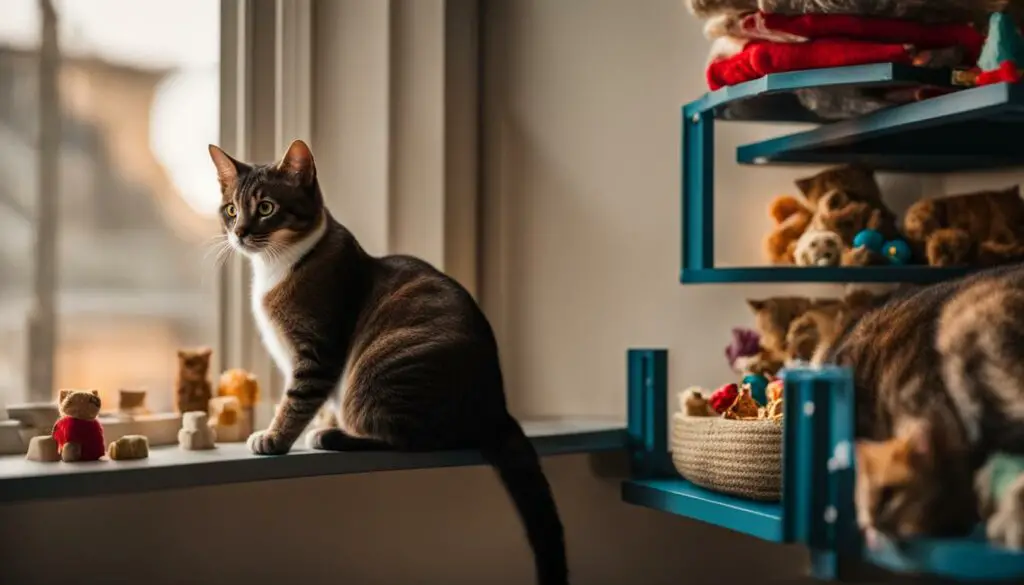
Tips for Encouraging Lap Sitting
If you want to encourage your cat to sit on your lap, there are a few techniques you can try. Gradual introduction is key, as you want your cat to associate sitting on your lap with positive experiences. Start by creating a comfortable and inviting lap space, such as a soft blanket or cushion. Use positive reinforcement techniques like offering treats or praise when your cat shows interest in sitting on your lap. This will help them make a positive connection with the experience.
Another effective method is to incorporate lap sitting into your daily routine. Set aside dedicated lap time each day where you invite your cat onto your lap and spend quality bonding time together. This consistency will help your cat become more comfortable with lap sitting.
It’s important to note that not all cats will be inclined to sit on laps, and that’s okay. Every cat has their own preferences and comfort levels. Some cats may prefer alternative ways of bonding, such as playing interactive games, grooming sessions, or simply sitting next to you. Respect your cat’s individuality and focus on building a strong and trusting relationship through activities they enjoy.
Remember, patience is key when encouraging lap sitting. Some cats may take longer to warm up to the idea, while others may never feel comfortable sitting on laps. The goal is to create a positive and comfortable environment for your cat, where they feel safe and loved, regardless of whether they choose to sit on your lap or not.

Table: Lap Sitting Techniques
| Technique | Description |
|---|---|
| Gradual Introduction | Introduce your cat to sitting on your lap gradually, using positive reinforcement techniques. |
| Dedicated Lap Time | Set aside daily lap time to invite your cat onto your lap for bonding and cuddling. |
| Alternative Bonding | Respect your cat’s preferences and engage in activities they enjoy, such as interactive play or grooming sessions. |
| Patience and Acceptance | Understand that not all cats will enjoy sitting on laps, and focus on creating a loving and comfortable environment for your cat regardless of their lap preferences. |
Dealing with Cats that Refuse to Sit on Laps
While many cats enjoy sitting on their owners’ laps, some cats simply prefer not to. It’s important to respect and accept your cat’s preferences rather than forcing them to do something they’re uncomfortable with. Forcing a cat to sit on your lap can lead to stress and resistance, which can negatively affect your bond with your feline friend.
To maintain a strong bond with your cat, focus on alternative bonding activities. Interactive play sessions can be a great way to engage with your cat and provide them with the attention they desire. Use toys to stimulate their hunting instincts and spend quality time engaging in play. This not only helps build trust but also provides mental and physical stimulation for your cat.
Grooming is another bonding activity that can help strengthen the bond between you and your cat. Brushing your cat’s fur or using a grooming glove can be a relaxing experience for both of you. Additionally, providing cozy spots near you where your cat can relax, such as a comfortable bed or a soft blanket, creates a sense of security and closeness.
Alternative Bonding Activities:
- Interactive play sessions
- Grooming
- Creating cozy spots near you
Remember, each cat has their own unique personality and preferences. By understanding and accepting their individuality, you can foster a loving and harmonious relationship with your cat, even if they prefer not to sit on your lap.
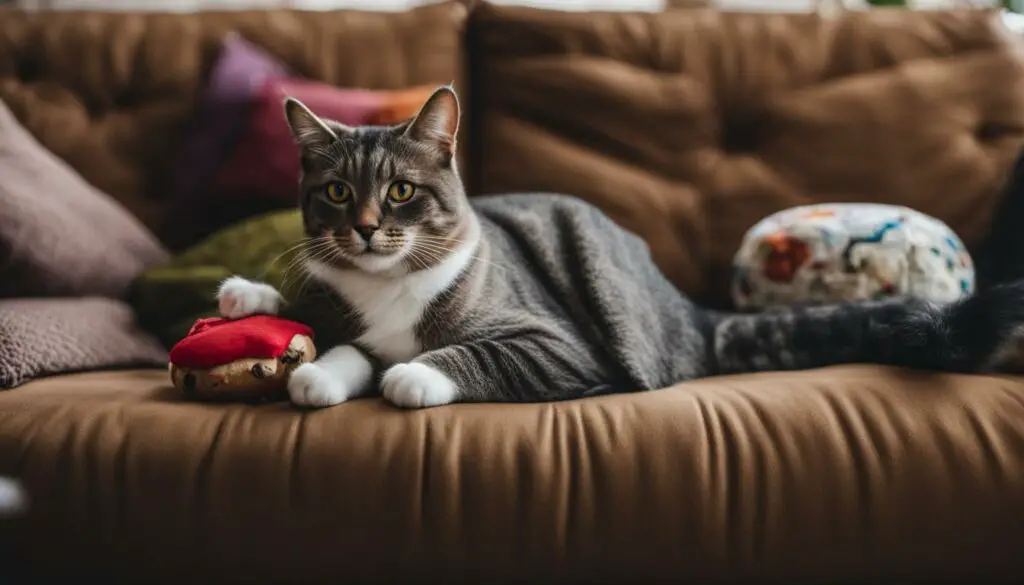
Conclusion
In summary, understanding cat behavior is crucial in effectively training and modifying their habits. By recognizing the signs of needy and demanding behavior, we can address the root causes and tailor our responses accordingly. Building confidence in insecure cats and setting boundaries with demanding ones are essential steps in creating a balanced and harmonious relationship.
Patience and consistency play a vital role in training cats, as it may take time for them to adjust and overcome their behavior patterns. Positive reinforcement techniques, such as providing rewards and creating a supportive environment, can greatly aid in their development.
It’s important to respect a cat’s preferences and not force them to sit on laps if they are not inclined to do so. Instead, focus on alternative bonding activities that they enjoy, such as interactive play sessions or providing cozy spots for relaxation. By understanding their preferences and building trust, we can strengthen our bond with our feline companions and ensure a happier and more fulfilling relationship.
In conclusion, nurturing a positive and understanding approach towards cat behavior and training can lead to a more balanced and satisfying companionship. By investing time and effort in building trust and respect, we can create a loving and mutually beneficial bond with our feline friends.
FAQ
How do I gently remove a cat from my lap without disturbing them?
To remove a cat from your lap without disturbing them, slowly and gently shift your weight or move your legs. You can also try distracting them with a toy or treat to encourage them to move on their own.
What are some signs of a needy cat?
Signs of a needy cat include following you everywhere, positioning themselves directly on top of or in front of what you are using, staring at you constantly, refusing to be left alone, and seizing any opportunity to rub against you or cling to your body.
How can I address needy behavior in my cat?
To address needy behavior in your cat, it is important to provide a stable and enriching environment, rule out any underlying medical issues, and gradually modify their behavior through techniques such as gently moving the cat away when they exhibit excessive rubbing or clinging behavior and rewarding them when they exhibit desired behavior.
What are some signs of a demanding cat?
Signs of a demanding cat include yelling at specific meal times, meowing incessantly until you pick them up, and climbing into your lap without invitation.
How can I deal with demanding behavior in my cat?
To deal with demanding behavior in your cat, it is important to ignore their attention-seeking actions and not engage with them when they yowl or demand cuddles. Instead, calmly move them away and continue to ignore their behavior. Consistently rewarding them when they are calm and not demanding attention will reinforce the desired behavior.
How can I identify the root cause of my cat’s insecurity?
Major changes in their environment, such as the departure or addition of a family member, can contribute to your cat’s clinginess or demanding nature. It’s important to observe their behavior and identify any significant changes that may have triggered their insecurities.
How should I tailor my response to my cat’s insecurity?
Once you have identified the cause of your cat’s insecurity, you can tailor your response accordingly. This may involve building their confidence through positive reinforcement, providing a stable and enriched environment, and giving them extra time to adjust to changes.
What role does patience play in training and modifying cat behavior?
Patience is key when training and modifying cat behavior. It may take time for your cat to adjust and overcome their neediness or demanding behavior. Consistency in training techniques, positive reinforcement, and creating a supportive environment are essential in helping your cat develop more balanced behavior patterns.
How can I encourage my cat to sit on my lap?
Gradually introducing your cat to sitting on your lap using positive reinforcement techniques, such as offering treats or praise, can help associate lap sitting with positive experiences. Ensuring a comfortable and inviting lap space can also make it more appealing for your cat.
What should I do if my cat refuses to sit on my lap?
Not all cats will enjoy sitting on laps, so it’s important to respect their preferences. Instead, focus on alternative bonding activities such as interactive play sessions, grooming, or providing cozy spots for them to relax near you.
How can I understand and address my cat’s needy or demanding behavior?
Understanding and addressing needy or demanding behavior in cats requires patience, consistency, and a deep understanding of feline behavior. By tailoring your training techniques to the specific needs of your cat and creating a supportive environment, you can help them feel more secure and develop positive behavior patterns.

